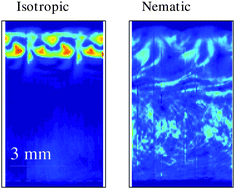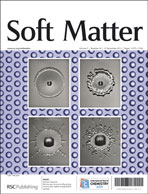Interplay between a hydrodynamic instability and a phase transition: the Faraday instability in dispersions of rodlike colloids†
Abstract
Strong effects of the Faraday instability on suspensions of rodlike colloidal particles are reported through measurements of the critical acceleration and of the surface wave amplitude. We show that the transition to parametrically excited surface waves displays discontinuous and hysteretic features. This subcritical behaviour is attributed to the shear-thinning properties of our colloidal suspensions thanks to a phenomenological model based on rheological data under large amplitude oscillatory shear. Birefringence measurements provide direct evidence that Faraday waves induce local nematic ordering of the rodlike colloids. While local alignment simply follows the surface oscillations for dilute, isotropic suspensions, permanent nematic patches are generated by surface waves in samples close to the isotropic-to-nematic transition and above the transition large domains align in the flow direction. This strong coupling between the fluid microstructure and a hydrodynamic instability is confirmed by numerical computations based on the microstructural response of rodlike viruses in shear flow.


 Please wait while we load your content...
Please wait while we load your content...